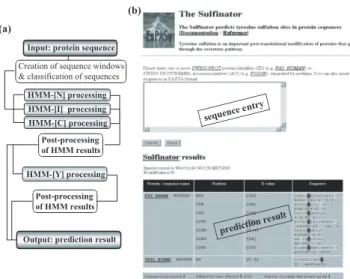The Sulfinator: predicting tyrosine sulfation sites inprotein sequences
Texte intégral
(2) F.Monigatti et al.. (b) (a) Input: protein sequence Creation of sequence windows & classification of sequences HMM-[N] processing HMM-[I] processing HMM-[C] processing. ntry nce e seque. Post-processing of HMM results HMM-[Y] processing Post-processing of HMM results. e sult tion r predic Output: prediction result. Fig. 1. The general architecture of the Sulfinator is shown in a flowchart (a). Screenshots from the Sulfinator web page illustrate the query form with input options available for the user (top) and the format of an output is shown (bottom) (b).. maximum weight algorithm (Krogh and Mitchison, 1995) for ‘weighting’ sequences in the multiple sequence alignment as well as the a priori mixture Dirichlet method. Detailed information on data sets used for this project can be found online (http: //www.expasy.org/tools/sulfinator/sulfinator-doc.html). The main HMM chain, HMM-[I], was built to recognize tyrosine sulfation sites within sequence windows centred around target tyrosines and was configured to find a single global alignment to the target sequence. Although sequence windows of 23 amino acids were used to construct HMM-[I], the best performing linear HMM chain only consisted of 17 amino acids, 5 N-terminally and 11 C-terminally to the target tyrosine. This led to the assumption that only 5 amino acids N-terminally to a target tyrosine seem to contain useful information to predict tyrosine sulfation events. HMM-[N], HMM-[C] and HMM-[Y] (Figure 1a) were, in contrast to HMM-[I], configured to find multiple domains per sequence, where each domain can be a local alignment. While constructing these HMMs, the ‘–gapmax’ value was lowered to 0.2, in order to control the ‘–fast’ model construction algorithm, which was used for all four HMMs. The reduction of the ‘–gapmax’ value ensures that fewer columns get assigned to the consensus and the models get smaller. To gain more independent control over the local alignment behaviour of HMM-[N] and HMM-[C], the ‘–swentry’ and ‘–swexit’ options were included, respectively. In case of HMM-[N] the probability value of ‘–swentry’ was decreased to 0.2,. 770. meaning that matching to HMM-[N] will not be forced to begin with the start state of HMM-[N]. However, once an alignment has started, it must continue over the full HMM length. The opposite situation can be found for HMM[C], where the ‘-swexit’ value was slightly increased to 0.7 to allow termination of an alignment to HMM-[C] at the C-terminus of a protein sequence. But, alignments have to start with the start state of HMM-[C]. In case of HMM-[Y], the ‘–swentry’ and ‘–swexit’ values were set on 0, to strongly penalize matching of fragments. In addition, the ‘architecture prior’(‘–archpri’) value was slightly increased to 0.9 in order to govern geometric prior distribution over HMM length and slightly favour longer models. All four HMMs are combined in the Sulfinator (Figure 1b), a perl script. The web interface to the Sulfinator is accessible on the ExPASy server at the URL http://www.expasy.org/tools/sulfinator/.. CONCLUSIONS Using independent test sets containing sequences with validated non-sulfated and sulfated tyrosine residues, the Sulfinator correctly predicts 98% of the tyrosine sulfation sites and 98% of the non-sulfated tyrosine residues (test sets are included in on-line documentation). To get an idea on how many proteins in a proteome might be sulfated, we scanned proteins from Homo sapiens, Drosophila melanogaster and Caenorhabditis elegans that are described in SWISS-PROT to go through the secretory pathway. The results from these proteome scans suggested that in each of these organisms one third of the proteins that enter the secretory pathway may contain on average two tyrosine sulfation sites per protein. We believe that in the era of proteomics, more emphasis will be placed on the characterization of post-translational modifications, and that bioinformatics tools for the prediction of specific post-translational modifications will be very useful in assisting the discovery of these important protein modifications. REFERENCES Eddy,S.R. (1998) Profile hidden Markov models. Bioinformatics, 14, 755–763. Han,K.K. and Martinage,A. (1992) Post-translational chemical modification(s) of proteins. Int. J. Biochem., 24, 19–28. Jung,E., Veuthey,A.-L., Gasteiger,E. and Bairoch,A. (2001) Annotation of glycoproteins in the SWISS-PROT database. Proteomics, 1, 262–268. Krogh,A. and Mitchison,G. (1995) Maximum entropy weighting of aligned sequences of proteins or DNA. Proc. Int. Conf. Intell. Syst. Mol. Biol., 3, 215–221..
(3)
Figure

Documents relatifs
Conservative Training, on the contrary, takes explicitly all the output units into account, by providing target values that are estimated by the original ANN model using samples
Introduced in [7, 8], hidden Markov models formalise, among others, the idea that a dy- namical system evolves through its state space which is unknown to an observer or too
We revisit this problem in a verification context: given k partially observable systems modeled as Hidden Markov Models (also called labeled Markov chains), and an execution of one
The Evidential EM (E2M) [5] is an interative algorithm dedicated to maximum likelihood estimation in statistical models based on uncertain observations encoded by belief
Unit´e de recherche INRIA Rennes, Irisa, Campus universitaire de Beaulieu, 35042 RENNES Cedex Unit´e de recherche INRIA Rhˆone-Alpes, 655, avenue de l’Europe, 38330 MONTBONNOT ST
We have proposed to use hidden Markov models to clas- sify images modeled by strings of interest points ordered with respect to saliency.. Experimental results have shown that
1) Closed Formulas for Renyi Entropies of HMMs: To avoid random matrix products or recurrences with no explicit solution, we change the approach and observe that, in case of integer
An efficient so- lution to make these methods more robust to domain shift is to first learn a word representation using large amounts of unlabeled data from both domains, and then